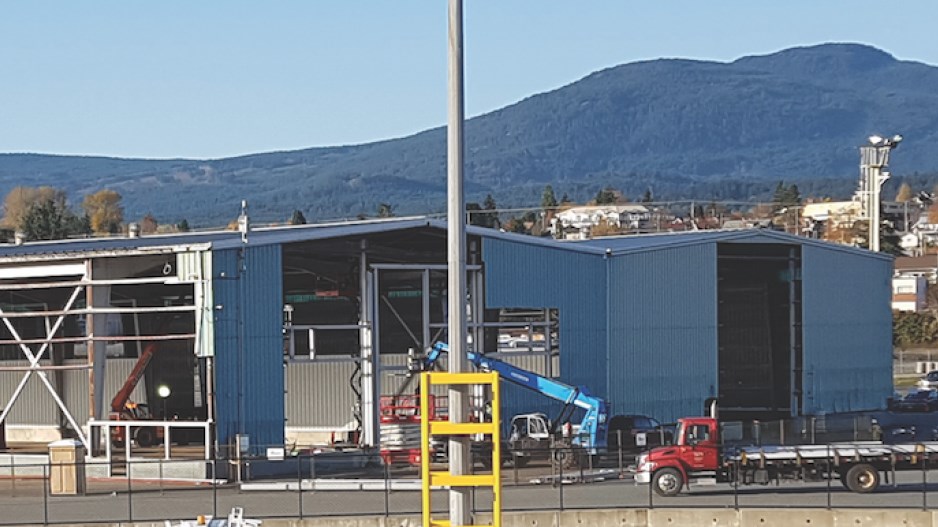With plenty of available mixed-use land and a willing city council embodying an open-for-business spirit, Nanaimo is poised to help boost B.C.’s import shipping infrastructure. A keystone of the Port of Nanaimo’s plans is the construction of the BC Vehicle Processing Centre (BCVPC), which will serve as the primary entry point for newly built European vehicles delivered to B.C. by sea.
In partnership with Western Stevedoring and its affiliate organization, the automotive division of SSA Marine, Port of Nanaimo has designed, built and financed the first-of-its-kind operation, which is expected to realign the vehicle supply chain in B.C.
“It is a change in trade patterns coming over by water, through the canal, down through B.C. and distributed to B.C.’s Lower Mainland,” says Port of Nanaimo CEO Ian Marr. “Moving further along, the project will feed Alberta and Saskatchewan.”
Vehicle shipments will travel through the Panama Canal to Nanaimo instead of from Eastern Canada by train.
Once arrived in Nanaimo, vehicles will be modified to conform to Canadian regulations and then shuttled by barge to the Lower Mainland or distributed to dealerships on Vancouver Island.
The project will be built in phases. In Phase 1, a 60,000-square-foot warehouse has been refinished to become a vehicle processing centre. It hosted its first shipment of Mercedes-Benz automobiles on March 8.
The warehouse will be operated by Western Stevedoring.
Following the arrival of the first shipment, vehicles will arrive every two weeks for the first year, totalling approximately 10,000 within Year 1.
The second phase will open more space for vehicles, which will bring the total footprint of the BCVPC project to nearly 27 acres of port land. The terminal expansion has created 25 jobs within the warehouse and another five on the marine works. About 60 jobs are expected to be created in the short term, then another 110 in the long term.
“We have other properties available for expansion to host that type of business should they be successful in moving in and bringing on other manufacturers,” Marr says. “There would definitely be room to expand.… We are hoping that would be the plan at this point.”
The project is a $19 million investment. The federal government contributed $6.3 million under the National Trade Corridors Fund.
The expansion comes at a time when Nanaimo’s focal downtown marina, infrastructure and key land plots are all being reconsidered as elements in a plan to turn the city into a big player in the B.C. shipping and tourism sectors.
“Our challenge is getting people to realize how close we are to the Lower Mainland and how some short sea shipping combined with where we are can be better for going into Vancouver,” says Marr. “[Nanaimo] is a viable alternative for a lot of things.”
According to BC Stats, Nanaimo’s population has grown by 7.1% since 2011, to 104,936 in 2016 from 98,021.
“The city’s current economic position is very strong and we are now in our fifth year of record building permits and growth in a row, so there is obviously a lot of change in the community,” says Nanaimo Mayor Leonard Krog.
“That is being driven by a balanced economy and central location.… This particular port facility and the port in general reflects the role of the city in being a hub of the main island and northern B.C.”
Nanaimo has traditionally been known as the Hub City due to the wheel-like configuration of inner city streets around its central port as well as its position as the main connector to Vancouver Island from the mainland.
Another recent development expected to help transform port operations in the city is a $15 million capital plan to improve the marina configuration to better serve commercial vessels.
The plan, developed by Saltspring Island-based InterTidal Design, will restructure the marina to make more room for moorage of commercial vessels. The plan will not take more space from the existing structure but instead aims to optimize the area with a more efficient layout.
The extension of the harbourfront walkway has long been considered an attractive option for luring tourism and increased activity to downtown businesses. The plan has been met with enthusiasm but had been shelved previously to prioritize other infrastructure developments.
“There is land available in this community for business and industry development,” Krog says. “I expect to see a significant reinvestment in marketing programming over the next several years, which repositions the municipality and the region as a go-to place.
“We are very positive about the future here – everyone has reason to be, but Nanaimo particularly has so much potential.”




